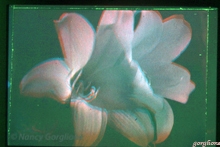
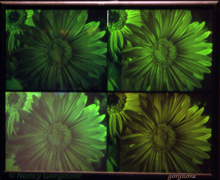
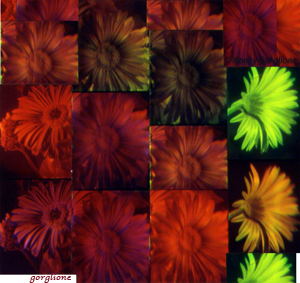
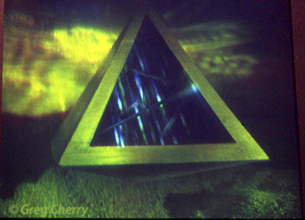
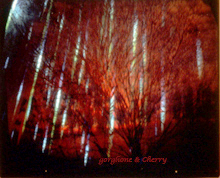
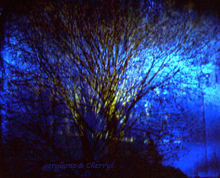
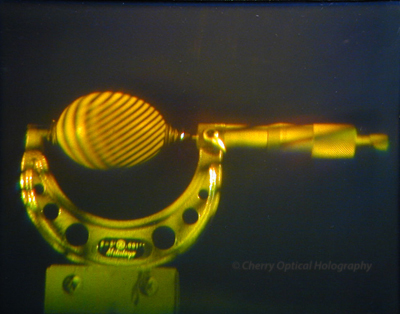
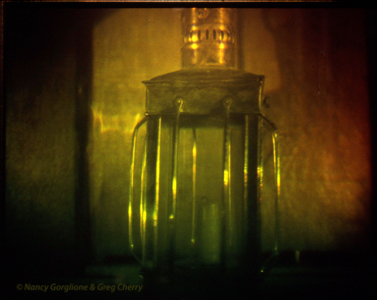
REFLECTION HOLOGRAPHY
Holograms are three dimensional images recorded with a laser beam onto photosensitive film. A hologram truly records space, or at least the in-phase space in front of the hologram when it was recorded .
Reflection Holograms are illuminated from the front. The Reflection Hologram reflects the viewing light to reconstruct the holographic image. When a reflection hologram is recorded, the recording laser beam’s wave fronts enter the holographic film from opposite directions. This records a phase hologram throughout the depth of the film emulsion, hence: a Volume Diffraction Grating.In-line reflection holograms, more commonly referred to as Denisyuk Holograms, utilize a single, evenly spread wave front of laser light. Ideally, the laser first passes through the clear recording media, onto the object. The light bounces, scatters, and reflects off the object and returns to the holographic recording medium. This results in very fine volume interference, but with limited depth.
An in-line Denisyuk reflection hologram of a bass cleff, holographed at the same time with an off-axis transmission diffraction grating Master. Nancy Gorglione, from the reflection hologram composite Cloud Nine.Off-Axis Reflection Holograms are created after separation of the laser into two separate wave fronts of light. The object light illuminates the object and continues to the film. The reference beam is reflected, expanded, and collimated by a series of front-surfaced mirrors and lenses that create an even spread of laser light. The reference beam enters from the back of the film plate, to interfere constructively with the object light at the film. This records a volume hologram throughout the depth of the holographic emulsion. This type of hologram is also called a "straight" reflection hologram, to defer it from an Image-Plane reflection hologram.
Straight off-axis reflection holograms have great parallax, which is the ability to see around the holographed objects to other objects. These types of reflection holograms can also record information beyond the edges of the holographic plate or film. RaceHorse Dream, partially pictured at left, is an off-axis (or straight) reflection hologram.
Cherry Optical Holography's Train Tunnel 20 by 24 inch image-plane reflection hologram.The Original Image-Plan Reflection Hologram.
Image -Plane Reflection Holograms are white-light viewable reflection holograms usually made from a Transmission Hologram Master. Using a Master can allow the artist to make multiple copies of the same hologram. Making a transmission hologram is also somewhat easier, as the stability requirements and exposure times are less. When laser illuminated, Transmission Hologram Masters can offer full parallax, wider angle of view, and larger image space. they also enable the holographic artist to make multiple copies, somewhat akin to a print in fine art.
An Image-Plane Reflection Hologram is made by projecting the pseudoscopic image from the Transmission Master forward, onto a glass holographic emulsion which allows the light to transmit through the emulsion from both sides. The projected Transmission Master becomes the three-dimensional object light. A reference beam is brought in from the back of the holographic plate so that interference can commence. Pictures of Image-Plane Reflection Hologram Set-Ups: below; and within the Color Control Scroll Box.Many of Cherry Optical Holography's holograms contain movement, mesmerizing to the viewer. Since holograms are three-dimensional images recorded on a flat film plane, movement adds parallax, depth, and textural elements to the kinetic scenery of our holograms. Types of holographic movement are illustrated in most of the pictures on this page. Movement within holograms has been created using numerous techniques: Moire patterns, shifting Shadowgrams, Interferograms, kinetic diffraction effects, Multiplex-integral slit hologram (movie) overlap, pseudoscopic parallax shifts, projection, and wide angle parallax are all part of the holographic magic within our three-dimensional designs.
SPACE-WITHIN-SPACE
And none are more magic than Greg Cherry's Space-Within-Space holograms, starting with his famous "Telescope" Hologram. For the historical record, I think Jody Burns holographed the first telescope that had a view through the projecting holographic eyepiece. Jody's Telescope was a Rainbow Transmission Hologram, though, while Greg Cherry's is a reflection hologram Telescope, which contains both vertical and horizontal parallax. Naive and kindlier Hippy times that the early days of Art Holography were, we actually asked Jody for permission to make a Telescope Hologram. (Nancy got the permission, but the subsequent Telescope Hologram is [almost] all Greg Cherry's.)
Greg Cherry's Telescope Hologram (version two.)In typical Cherry fashion, Greg actually made the telescope before he made the hologram. When making the Telescope Hologram, Greg first made a sub-Master of the view thru the eyepiece, a separate three dimensional hologram of a comet passing close by the Moon, Saturn, Jupiter and a few other heavenly bodies. (Here, Gorglione contributed a few planetary-looking spheres, by dipping Styrofoam balls into wet Plaster of Paris, then building and manipulating the surface textures as it dried.) Greg Cherry carefully orchestrated reference angles between Masters to assure bright visibility in the finished hologram.
View thru the eyepiece of
Greg Cherry's Telescope Hologram.
Today, imitations and holographic variants of the Telescope exist out there within the small fringes of Holo Land.For several, all too brief Reagan years, Holographic Art did get the "trickle-downs" and a worldwide economy of holograpic art existed. Subsequent years saw successive bankruptcies from galleries and Museums of Holography in the United States.
THE ART MEDIA OF THE AEON, Holographic Art for the Holocene, seems one more disappearing species. Yet, the innovative West Coast of the United States, especially California, may see the light to preserving its own culture. The Jury is Out, and the radioactive clocks are ticking....
Cherry Optical Holography's Donations.
Holograms are three dimensional images recorded with a laser beam onto photosensitive film. Reflection holograms are visible in white light. They reflect the viewing light, typically have high contrast; can have a wide angle of view on both vertical and horizontal axes; and can have parallax, depth and projection.
Clock by Nancy Gorglione,
In Line Reflection Hologram.
Race Horse Dream by Nancy Gorglione, (Off-Axis Reflection Hologram Shadowgram, Moire
(
after Muybridge's racehorse sequences.) close-up of detail.
White Lily
Multicolor Reflection Hologram by Nancy Gorglione. One of a series of color tests featuring multiple exposures. White from red-orange and blue green exposures. 1983
Once the basics of holography are understood, holographers were able to improvise set-ups with unique results dependent on the laboratory, imagination, and technical skill of the artist.
The Swinging Lantern, pictured, left by Greg Cherry featured 45 successive vertical slit holograms which gives movement to the finished 8 by 10 inch image-plane reflection hologram. The Swinging Lantern was exhibited as part of the Ship Wreck installation by Greg Cherry and Nancy Gorglione in San Francisco.
COLOR CONTROL
in Reflection HolographyIn Northern California, Holographic Artists explored techniques of color control in Reflection Holography. Reflection Holograms are easy to light from the front, and have a full view horizontally and vertically. A international market developed for reflection holograms, and local artists created 4 by 5 and then, 8 by 10 inch glass reflection holograms for sale. Eventually, 12 inch by 16 inch Agfa G. holography plates became available for reflection holography.
By the mid 1980's, collectors traveled to California from around the World to purchase our work.
Small Reflection Hologram Lab at Cherry Optical Holography. Partial view of Edgeless Plateholder, Reflection Collimating Mirror, and
Image-Plane Reflection Set-Up.Gorglione began making reflection hologram composites in the late 1970's:
I wanted to expand the size format into larger pieces, and I wanted to explore the color relationships possible with holography. Color control was really exciting, producing almost an infinite palette of additive mixture of colors.
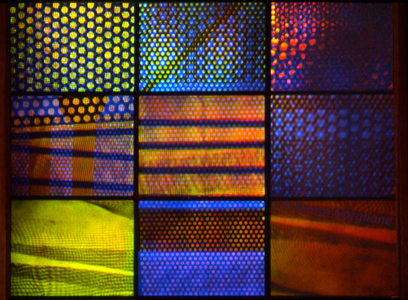
Color Tests, reflection hologram composite by Nancy Gorglione. Multiple exposures create additive mixtures of colors that are kinetic in the finished hologram composite.
When you paint, the colors subtract light from each other to form the pigments on the canvas. Hence, the color mixing is called Subtractive Mixture of Colors. With holography, the artist gets to explore the additive quality of the colors of light. I discovered that opposite colors on a color wheel add up to white. By just "kissing" the plate with a brief second exposure in a different color, you can get pastels and metallic colors. Varying exposure densities and development times can also produce variations of color in reflection holography.
Of course, each color diverges slightly differently in space. Picture the rainbow of light through a prism. This familiar separation of the frequencies into the primary colors illustrates each color emitting at a slightly different angle. In holography, you have to compensate for this difference in colors by adjusting the angle of the plate between exposures; and sometimes, other optical changes dependent on the desired frequency of color.
A Random Spin 4 by 5 inch reflection hologram of interfering light randomly colored by an errant spin.
In the Dark, Under the Safe LightAt Cherry Optical Holography, first we soak the unexposed emulsion in a solution of water and a wetting solution - commonly triethanolamine - which swells the emulsion. In order to get an even swelling of the gelatin-based emulsion, we either spin coat the wet plate, or, more commonly, squeegee it with a truck window wiper blade to make sure the swelling is even. Next, we use a hair dryer to dry the wet plate; then we load the plate in the plate holder; settle the set-up to allow air currents and any table movements to dampen out; then make the exposure.
Following the first exposure, we soak the plate again in a different ratio of wetting solution, spin or squeegee it, dry, change the optical set-up, load the plate into the plate holder and made the second exposure. It is a lot of work literally in the dark. Reliable panchromatic holographic recording materials are rendering parts of the process obsolete. Painting with light and the additive mixtures of color is really exciting to have such a fabulous media to explore!
Greg Cherry's Spin Coater, designed for 12 by 16 inch glass plates. It has a strong motor to power it up and spin it rapidly. (Don't try this at home!)In 1988, Nancy Gorglione published an article in S.P.I.E.'s Applications of Holography (available at their site) describing additional variants in color control in Reflection Holography.
Eventually Agfa-Gaevert was sold to Bayer in the late 1990's, and they ceased manufacturing holographic materials. Illford Scientific all too briefly made green sensitive 20 by 24 inch glass holographic plates and sheet film. The Illford materials took large exposure times at the short green wavelength, adding to the "vibration-isolation" and "laser cost" problems.
In the early 1990's Slavich began manufacturing holographic film. At various times, they've produced multiple wavelength holographic film. A few other very small companies have lovingly ventured into color holographic film. Since some films are now panchromatic, all you need are a variety of (TEM00) colored lasers, rendering the above "trieth" obsolete.
SpaceBook by Greg Cherry and Nancy Gorglione, image-plane reflection hologram. The open book contains a wide parallax scene which continues beyond the boundary of the book's page. "The Printed Word Hosts Space."
Lily Plate by Nancy Gorglione, reflection hologram -off-axis masked deep space diffraction hologram. From Woman as Music by Gorglione, multicolor reflection hologram composite. Collection R. Lewison

The holograms pictured on this web page were all made with a continuous wave laser. In holography, the path lengths of the laser beam have to match in length in order to have the positive phase relationships which start the exposure of the hologram. Measuring the path lengths of laser light along the stable table starts at the beam slitter, #2, below. A Stable Table is the prosaic name for the vibration isolation system necessary for continuous wave holography, where movements and air currents put the system out-of-phase.
The first three holograms by N. Gorglione on the viewer's left illustrate the different primary types of reflection holograms.
The top Clock is a Denisyuk (single-beam) reflection hologram. This type of hologram has great angle of view and resolution but little depth.
RaceHorse by Nancy Gorglione is an off-axis reflection hologram from the reflection hologram composite, RaceHorse Dream, close-up of detail shown here. Nine 8 by 10 inch multiple exposure hologram plates are arranged together to tell a story. Diffraction and moire effects, color separation and overlapping colors create a kinetic composition that's angle of view extends beyond the plate edges.
Basket of Eggs by Gorglione has a projecting basket handle, while the eggs straddle the "image-plane" or surface of the holographic plate. It's an image-plane reflection hologram, created from the projecting pseudoscopic image of a transmission Master hologram of the original basket of eggs.
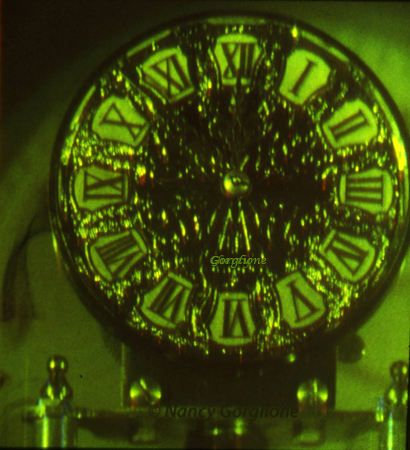
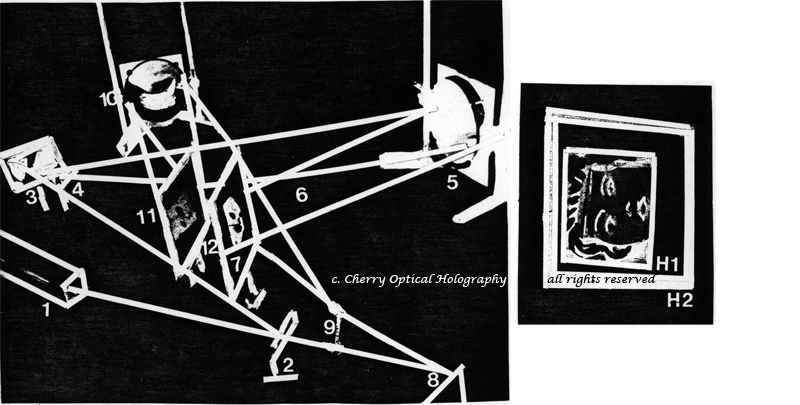
Image-plane Reflection Hologram Set-up by Cherry Optical Holography, all rights reserved. This is an older graphic - lines of tape on a black board - to represent the laser beam paths; but the set-up yields good results. We have a small 4 foot by six foot steel-toped cement block stable table usually used for copying transmission Masters as image-plane reflection holograms. 1. Laser, here, a 30 mw helium neon laser, 532 nm. The laser travels to 2. Beamsplitter, a front-surfaced graduated coating varies the amount of reflected beam of laser light. 3. Reflected laser beam hits a front surfaced mirror, reflects off the mirror, and goes through 4. A spatial filter, which focuses the point of laser light through a pinhole, which cleans up the mode of the laser light; and, through a microscope objective, a lens element which spreads the laser into a uniform spherical wave of diverging laser light. The spacial filter is located within the collimation distance of 5. A Collimating Mirror, which reflects the spreading wavefront of laser light into a collimated (non diverging) beam of light. Now the Reference Beam, which is directed at the holographic film at an angle, which becomes the reference angle 6. The Reference Angle is the angle of the reconstruction light for the finished hologram. This whole path from the beamsplitter is the Reference Beam Path. 7. Copy Plate Holder where the finished hologram H2 is exposed. 8. The portion of the laser beam which transmits through the beamspitter becomes the Object Light or Object Beam. It strikes a front surfaced mirror, which directs it through a second spacial filter, #9. The diverging beam, cleaned up by the spacial filter as described in #4, strikes another collimating mirror #10. The now-collimated Object Light transmits through the original holographic Master H1, a transmission hologram, #11; To project the pseudoscopic image to the holographic plate, #7. The pseudoscopic image becomes the object. As a general rule, the bigger the transmission Master hologram, the more parallax in the finished reflection hologram copy. The Object path lengths and the Reference path lengths must be equal, measured from the Beamsplitter, #2; to the Holographic Plate, #7.
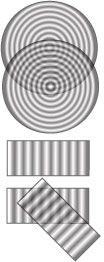
Egyptian Memories by Greg Cherry is a multicolor image-plane reflection hologram utilizing space-within-space imagery. Edition of 25 and artists' proofs. Greg Cherry's space-within-space reflection holograms are pictured in If You Can See It, It's Not There.
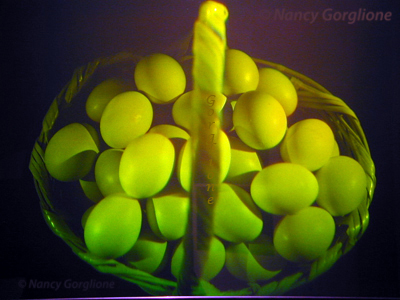
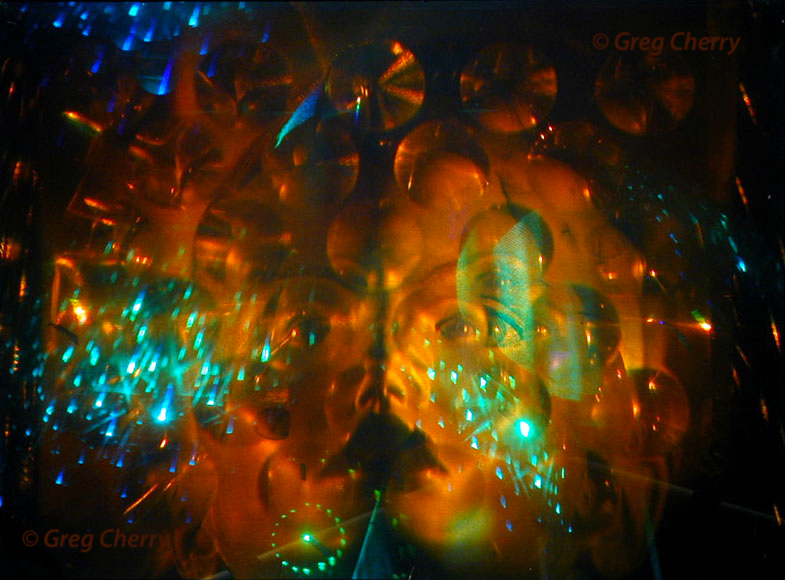
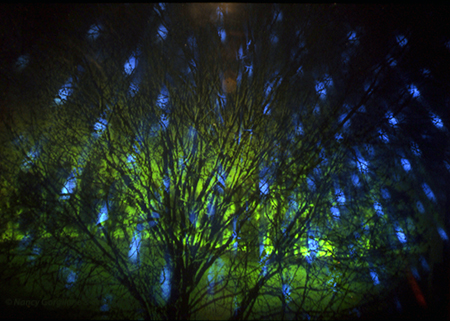
Clocks, above, pictures a real-time, Integral or multiplexed reflection hologram, with animated movement of the clock hands. The hands on the right clock move forward, and the hands on the left clock move backward. Both movements are visible simultaneously in the finished, white-light viewable hologram.
To make this hologram, Greg Cherry digitally controlled a mechanical slit which successively exposed about 100 slit-frames of holographic film. The clock hands moved by increments between each exposure. The Master for this hologram was originated as a sub-Master for Painting Time and Space; both Clocks and Painting Time & Space were copied by Hughes Power Products into photopolymer holographic film; both images by Greg Cherry and Nancy Gorglione.
After the holograms were completed Greg Cherry discovered that the radium painted dial of the backwards moving clock was highly radioactive.
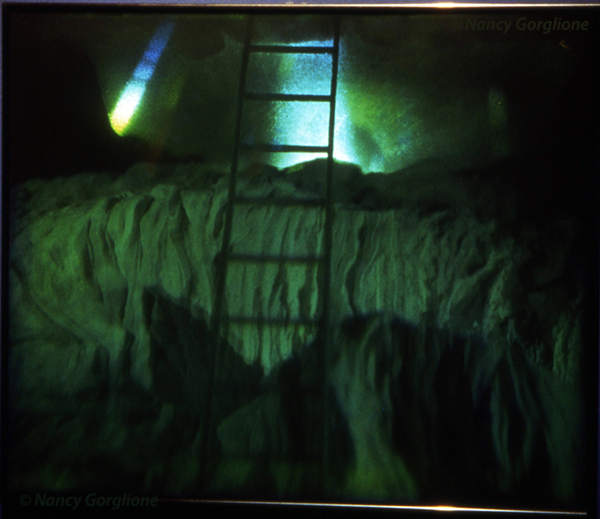
Mountain Ladder, by Nancy Gorglione, pictured left, combined an image-plane reflection hologram of mountains and a projecting ladder with pseudoscopic flashes of diffraction sky. This 12 by 16 inch hologram was originated for the reflection hologram composite, Journey.

UNIVERSAL HOLOGRAM Home of Cherry Optical Holography Finest Holograms by Nancy Gorglione & Greg Cherry
|
|||
Reflection Hologram Art and Technology |
|||
|
|
|||
|
universalholo@comcast.net |
All Contents Copyright © 2017 |
|